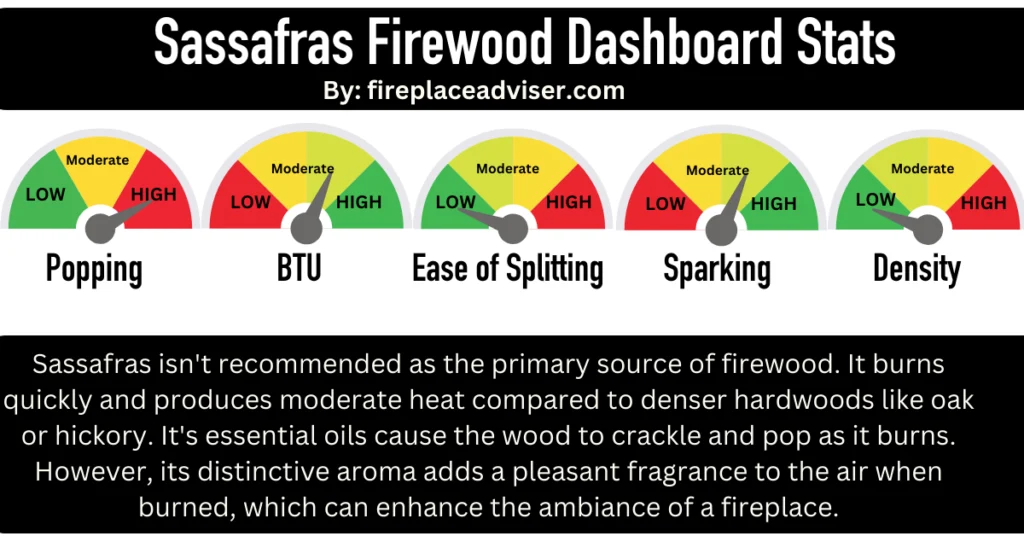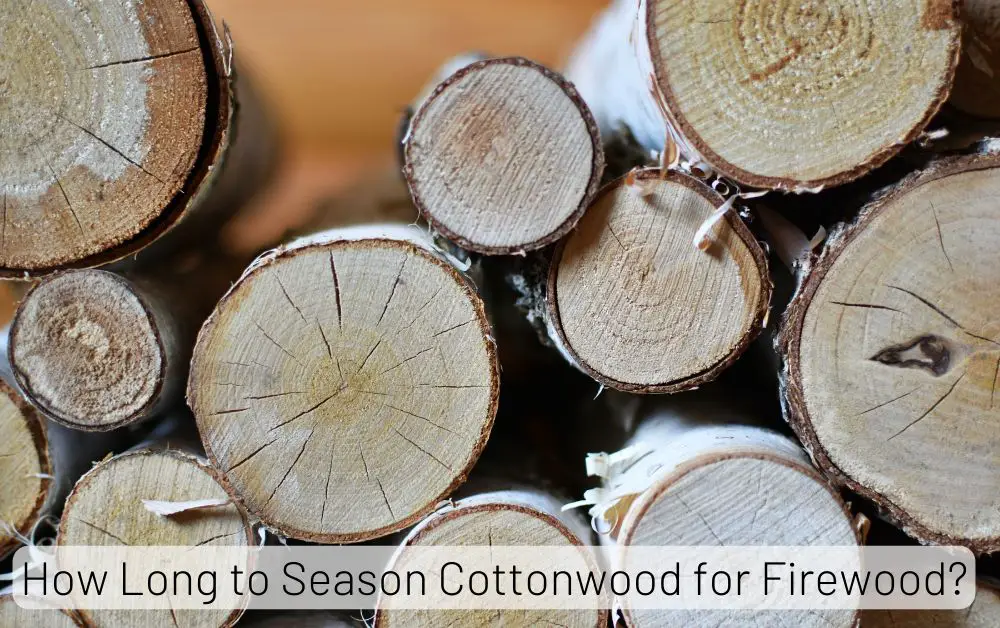There are numerous options when choosing firewood for your fireplace or wood-burning stove. With its distinctive aroma and unique characteristics, Sassafras often finds itself in the spotlight as a potential candidate.
But before tossing a stack of sassafras logs into your fire pit, it’s crucial to delve deeper into its properties and suitability as firewood. So, is sassafras good firewood?
Overview
| Characteristic | Description |
|---|---|
| BTU | Moderate; approximately 18.9 million BTUs per cord. |
| Smoking | Moderate; produces a pleasant aroma when burned. |
| Popping | High; Popping may occur. |
| Sparking | Low; produces few sparks when properly seasoned. |
| Ease of Seasoning | Moderately easy; dries relatively quickly compared to other hardwoods. |
| Ease of Splitting | Easy to moderate; tends to split easily when green, becomes harder as it dries. |
| Moisture Content | Initially high; around 50-60% when freshly cut, decreases to 20-25% when properly seasoned. |
| Wood Density | Less dense compared to some other hardwoods, making it easier to handle and split. |
| Flame Color | Produces a yellow flame with hints of blue. |
| Fragrance | Pleasant, sweet aroma reminiscent of root beer. |
| Burn Time | Moderate; burns relatively quickly compared to denser hardwoods. |
| Resin Content | Moderate; creosote buildup in chimneys. |
| Ideal Uses | Ideal for use in fireplaces, wood stoves, and outdoor fire pits. |
| Environmental Impact | Sassafras is a fast-growing tree species and considered sustainable when harvested responsibly; replanting is recommended to maintain forest health and biodiversity |
| Safety Considerations | Minimal; like all fires, proper pre. |
Is Sassafras Good Firewood?
Sassafras isn’t recommended as the primary source of firewood. It burns quickly and produces moderate heat compared to denser hardwoods. It’s essential oils cause the wood to crackle and pop as it burns. However, its distinctive aroma adds a pleasant fragrance to the air when burned, which can enhance the ambiance of a fireplace.

Pros of Sassafras Firewood
-
Sassafras wood burns with a pleasant aroma, which can add to the ambiance of a fire.
-
Sassafras is relatively easy to split compared to other hardwoods, making it more manageable for those chopping firewood.
-
Sassafras firewood tends to dry relatively quickly compared to other hardwoods, which means it can be ready to burn sooner after being cut.
-
While not as high as some denser hardwoods, sassafras still provide a good amount of heat, making them suitable for heating smaller spaces or using other firewood.
-
Depending on your location, sassafras trees may be abundant, making it a readily available option for firewood.
-
It has a natural resistance to rot, which means it can last longer in outdoor storage than other types of firewood.
-
It produces fewer sparks than other types of firewood, which can be advantageous for indoor fireplaces or situations where sparking may be a concern.
Cons of Sassafras Firewood
While sassafras firewood has its advantages, there are also some drawbacks to consider:
-
Sassafras tends to burn relatively quickly compared to denser hardwoods. This means you may need to replenish the fire more frequently, which can be inconvenient, especially during long, cold nights.
-
While sassafras do provide moderate heat, they may produce less heat than denser hardwoods like oak or hickory. This can make it less suitable for heating larger spaces or use in freezing weather.
-
Burning sassafras wood can lead to creosote buildup in chimneys if not correctly maintained. Creosote buildup can pose a fire hazard and necessitate more frequent chimney cleaning.
-
If you’re looking for firewood that will provide a long, sustained burn, there may be better choices than sassafras due to their faster burn rate.
-
It can produce a fair amount of soot and residue, which may require more frequent cleaning of your fireplace or wood stove.
-
While some people enjoy the pleasant aroma of sassafras wood when burning, others may find it too strong or even irritating, especially if they have respiratory sensitivities.
Related Post: Is Poplar Good Firewood?
Essential Consideration for Using Sassafras Wood as Firewood
Using sassafras wood as firewood can be a viable option, but there are several essential considerations to remember. Firstly, sassafras trees are native to eastern North America, so ensure that harvesting or obtaining sassafras wood is legal and sustainable in your area.
Secondly, like most types of firewood, sassafras should be properly seasoned before use. This involves allowing the wood to dry out sufficiently, typically for at least six months to a year, to reduce its moisture content. Burning green or unseasoned wood can lead to excessive smoke, poor combustion, and creosote buildup in your chimney, which can be a fire hazard.
Regarding density and heat output, sassafras wood is relatively lightweight and less dense than hardwoods like oak or hickory. While it burns relatively quickly, it may produce less heat than denser wood. Therefore, mix sassafras with other hardwoods for a longer-lasting, hotter fire.
Sassafras can impart a pleasant aroma when burned, similar to its distinct smell when freshly cut. Some people enjoy this fragrance, while others may find it too strong or distinctive for indoor fires. Consider your preferences and any potential sensitivities before using sassafras wood indoors.
When burning sassafras wood indoors, be mindful of smoke and emissions. While sassafras wood produces less smoke than other softwoods, it may still emit more smoke than dense hardwoods.
Proper ventilation is essential to avoid the accumulation of harmful gases and particulate matter. Safety should be the top priority when using any firewood.
Therefore, it’s crucial to implement appropriate fire safety measures, including using a fireplace screen to contain sparks, maintaining distance between flammable materials and the fire, and never leaving a fire unattended.
Be aware that burning certain woods, including sassafras, can release compounds that may irritate the respiratory system in sensitive individuals.
It’s also important to consider potential allergies. Some individuals may be allergic to sassafras wood or its smoke. If you or anyone in your household has known allergies or sensitivities, exercise caution or consider alternative firewood options.
Lastly, ensure that harvesting sassafras wood is done sustainably and responsibly to minimize environmental impact. Avoid cutting down healthy trees indiscriminately and consider sourcing wood from certified sustainable sources or using fallen or deadwood where possible.
Related Post: Is Sycamore Good Wood?
Final Thoughts: Is Sassafras Good Firewood?
In conclusion, while sassafras offers certain benefits as firewood, including its pleasant aroma and ease of burning, it may not be the most efficient option for long-lasting heat. Its rapid burning rate and lower heat output make it better suited for specific uses, such as starting fires or providing quick warmth in smaller spaces.
However, when used responsibly and sustainably, sassafras can be viable for those seeking a unique and aromatic firewood option.
As with any firewood selection, weighing the pros and cons and considering factors such as availability, environmental impact, and safety precautions is essential.
Affiliate Disclosure: Fireplaceadviser.com is a participant in the Amazon Services LLC Associates Program. We may earn a commission when you click on certain links on this site and purchase.

Hello!! I am Jamal Khan. I often fix my home electric heaters and gas stove problems and research the common issues in the heating units to improve my knowledge and expertise. The aim of establishing fireplaceadviser.com is to share my expertise and knowledge with my audience.


















